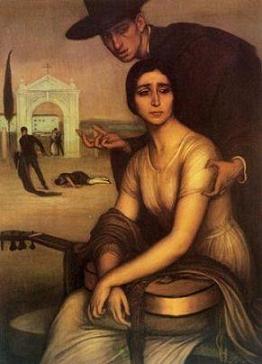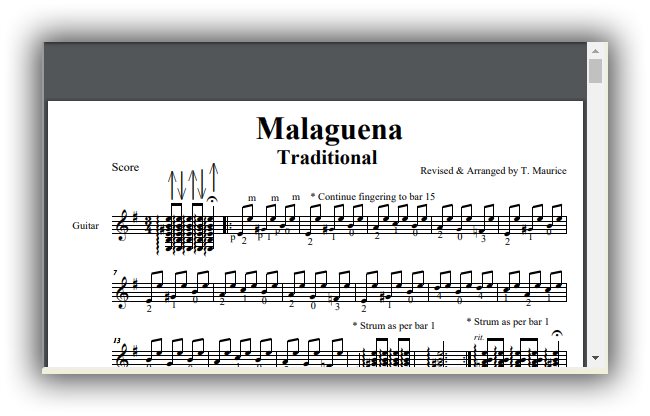- Home
- Classical Fingerstyle Portal
- 15 Actionable Guitar Lessons
- Classical Guitar Technique
- Guitar Lessons
- Beginner Lessons
- Guitar History
- The Renaissance Guitar
- Guitar Time Line
- Classical Guitar Blog
- Contact
- About Author
- Site Search
- Privacy Policy
- Site Map
- Classical Guitar Study Course 3.0
- Instant Classical Guitar Repertoire
- Classical Guitar Lessons For Beginners
Malaguena
 Malaguena is a fun piece to play.
Malaguena is a fun piece to play.Julio Romero de Torres [Public domain]
Malaguena is a fun piece to play.
It's a traditional Flamenco piece, but classical guitarists love to at least think they're a flamenco player, if only for a few minutes :)
All jokes aside, there are many techniques used in this piece that aren't always practiced and mastered in the classical guitar realm.
Indeed, the piece begins with some rasgueado strum chords. This is where you "lead" with the fingers in the downstroke and play upwards (1st "E" string to bass "E") string) across the strings with your thumb.
You'll notice the arrows above the chords in the first bar indicate which way the strings should be strummed.
Don't Just Get a Head Start - Get a FAST START!
One of the biggest challenges in learning to play classical guitar is to know where to start.
That's why I created the ‘Classical/Finger Style Guitar Lessons Portal’ which helps you to make a fast and logical start. You can join here...
https://www.learnclassicalguitar.com/Classical-Guitar-Fingerstyle-Portal
Oh, and did I mention - it’s FREE? 😊
Just
follow these 3 easy steps...
1. Enroll in the Classical-fingerstyle Lesson Portal here...
https://www.learnclassicalguitar.com/Classical-Guitar-Fingerstyle-Portal
2. Select the lessons you want to practice
3. Start making progress on the classical guitar
If you're really serious about learning classical guitar, you can also download your copy of...
"Ten Important Skills You Need as a Classical Guitarist" (inside the portal).
P.S. If you resonated with this idea I think you're going to love how the portal gives you an advantage and a fast start in playing classical guitar. You can join in literally seconds here...
https://www.learnclassicalguitar.com/Classical-Guitar-Fingerstyle-Portal
The fingers in the downstroke move as follows: a (annular) finger; m (medio) finger; i (indice) finger.
If you watch the video they move in a "fanning" movement one after another, although rather fast. It helps to create a very Spanish, even Flamenco sound, which is a lot of fun to do.
It takes a bit of practice, but if you work through it slowly then it's easier to master. These rasgueado chords reappear throughout the piece, and they're all played basically in the same manner.
In the first section of Malaguena, (bars 2-15) you use the combination of thumb (p: pulgar) and 2nd finger (m: medio).
This allows you to play the notes both accurately and with a good deal of speed. In the next section, (bars 19-32) you notice it's the same bass (melody) notes, although it is played in triplets. This just means you're playing three notes in the time of two.
It creates a great sound, and it feels good to get a good rhythm going. You have to be careful to keep the rhythm even throughout the entire piece.
In the next four sections, (bars 34 - 60) I've written a small "interlude" in keeping with the basic feel of a Malaguena.
Malaguena Sidebar - Did You Know?
The Malaguena is a folk-dance form which originated in Malaga, Southern Spain.
This type of music is both a song to be sung and an instrumental piece, and it often incorporates a bass pattern of AGFE, which you can see I've included in bars 34–36.
You'll also notice the change in time signature to help give it a different feel before returning to the original notes and patterns.
Also, there's a melodic 'lead' line that moves in a downward motion on the frets of the first string, with the notes going in a contrary motion, i.e., upwards on the frets. Its character is in keeping with the flamenco feel of the piece and includes both triplets and slurred grace notes.
After that, the AGFE pattern returns once more and ends with a rolled chord followed by a harmonic note struck on the 1st "E" string at the 12th fret.
You'll notice here (and in other parts of the piece) that there's a small semi-circle sign with a dot inside hovering over the harmonic note. This is called a "fermata," and it means to hold the note longer than usual to stretch it out.
You'll also notice the harmonic note itself has a diamond-shaped, clear head.
This is traditionally how harmonic notes are indicated in guitar music. The next section (bars 46–50) is in pizzicato (pizz).
This is achieved on classical guitar by placing the fleshy part of the hand nearest to the little finger on the strings themselves, close to the bridge (where the strings are anchored).
The sound produced is a comical, muted sound, but quite effective and interesting to the ear. The pizzicato also has another marking at the 55th bar, namely: accelerando (accel.), which means gradually playing the notes faster.
At bar 60, there's another fermata, which then leads into the final section of the piece, which includes both tremolo (16th notes) and rasgueado chords to finish the piece in a flamenco flourish of character and dynamism, and of course, fun!
The tremolo should be played evenly, and you can achieve this by practicing it slowly and counting: "1 a and a, two a and a" etc
Another tip to achieve a clear tremolo is to practice it very slowly, but in a staccato (short and detached) fashion.
It helps with both accuracy and articulation. Even though the bass melody is still being played with the thumb, you don't want the thumb to overwhelm the other notes; rather, it should be part of the four-note cycle, though admittedly louder than the accompanying notes of the tremolo.
Overall, there are many techniques, both classical and flamenco, contained within the Malaguena.
The most important point to remember is to have fun with it and don't get too hung up on played exact time values, as the piece needs to have character and "breathe" a little bit.
Here's a YouTube video of Malaguena..
Go here to "Like" and "Comment" on the Malaguena video...
 Malaguena - Traditional Spanish Music
Malaguena - Traditional Spanish Music Malaguena Download
Malaguena DownloadRecent New Pages:
What is Classical Guitar Playing?
Arpeggio Beginner Guitar Lesson Classical-Fingerstyle Portal
Blog Technique Free Guitar Lesson
Guitar History Guitar Instruction Guitar Lessons
Guitar Time Line Malaguena Memorizing Music
Music Notation Music Notation Primer Sight Reading
Sight Reading Guide Theory Work Sheets Renaissance Guitar
